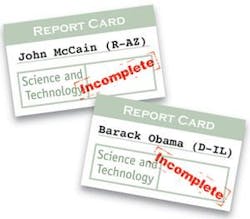Although the presidential primary season intrigued even indifferent voters, the run-up to the election is proving less energizing. We’ve seen Barack Obama (D-IL) in Germany and John McCain (R-AZ) at a German restaurant in the U.S. We’ve heard them discuss the economy and politics in the Middle East. But where do the candidates stand on science and technology issues?
Nonspecific
Getting the answer to that question isn’t easy. Mr. Obama’s campaign lays out his plans for scientific research on his Web site in a section titled, “Barack Obama: Investing in Science Research.” Under the headings “Science and Innovations,” “Biomedical Research,” “Support for Education,” and “Diversity for Innovation,” the campaign lists priority areas that Obama will pursue if elected. In the area of biomedical research, for instance, Obama would strengthen funding and “better improve the efficiency of that research by improving coordination both within government and across government/private/nonprofit partnerships. An Obama Administration will ensure that we translate scientific progress into improved approaches to disease prevention, early detection, and therapy that is available for all Americans.” Plans also call for advancing stem-cell research and fighting health disparities among racial and economic groups.
Regarding science and technology, Obama says he will support doubling federal funding for basic research, refining tax laws to support investment, adjusting patent policies to address rapidly changing technologies, and ensuring “regulatory policies both protect the public and encourage risk-taking by researchers.” He would also appoint a chief technology officer to oversee the federal government’s communications infrastructure. Focusing on the Internet, Obama wants to extend access to every community in the U.S. In addition he’ll boost what the Federal Communications Commission currently defines as broadband: just 200 kbit/s.
The campaign was not willing to be interviewed.
Inscrutable
Discovering John McCain’s plans for science and technology requires more detective skill—more, even, than I possess. While his Web site has sections on climate change, energy, and health-insurance reform, it fails to enumerate an approach to science and technology. I called the McCain campaign asking for information on such a plan and was told to e-mail my request. When I did that, I received the following response: “Thank you for your request. Unfortunately, we are unable to provide comment at this time.” I again called McCain headquarters, this time explaining that I had information on Obama’s science agenda and wanted to present both points of view in my column. The young staffer said, “Well, send another e-mail. It might help get a response if they know you have information from the Obama campaign.”
McCain’s office, too, declined an invitation to be interviewed.
Barely visible
While it’s important to know where each candidate stands on the issues, it’s troubling to see that science and technology are not priority issues in the campaign. Obama does have “Technology” listed as one of his main issues on his site, but “Science” is tucked under “Additional Issues,” along with “Sportsmen,” “the Arts,” and “Child Advocacy.” While these are important topics, it seems as though issues related to science and technology—key forces behind the economy, health care, and defense—should find their way into debates and stump speeches.
At the very least, each candidate should have a coherent plan that shows how science and technology relate back to a strong domestic economy, a powerful and fully competitive world power, and a nation advancing world health.
Failure of media
One of the reasons for the low interest in science and technology is “lack of imagination and poor reporting by the mainstream media,” according to Shawn Otto, CEO of Sciencedebate2008, an initiative cosponsored by the American Association for the Advancement of Science, the Council on Competitiveness, the National Academy of Sciences, the National Academy of Engineering, and the Institute of Medicine. Otto contends that most news editors don’t allow political reporters to cover science stories, even though many key political problems revolve around science. Without coverage, “there’s no one to help focus the public’s attention and to hold the candidates accountable on the issues that affect people’s lives,” Otto explains.
But Americans, who eagerly watch numerous TV programs devoted to science topics, want to know where the candidates stand on science and technology. Polls conducted by Sciencedebate2008 found that 85% of Americans would like to see the candidates debate key science questions and 72% would be more likely to vote for a candidate who commits to using science to tackle America’s major challenges.
The only reasonable course
Otto points to the science community’s lack of political organization as another reason that science is not at the forefront of campaign issues. “The candidates assume [science] is a niche subject, requiring a lot of preparation for relatively few votes, which is a mistaken assumption,” he asserts.
A key challenge to the science and engineering communities is to become more involved in the political process. While meeting with congressmen and senators is important, Otto suggests that the most positive change will come from scientists speaking out in public and running for office. “This is a nation founded in part by scientist-statesmen like Franklin and Jefferson, and unless today’s scientists assume some responsibility for being a voice in the process, our nation will be in for some hard times,” he says. “For reason to continue to shine forth as an American value and quality, reasonable people must step up to the plate.”
About the Author


